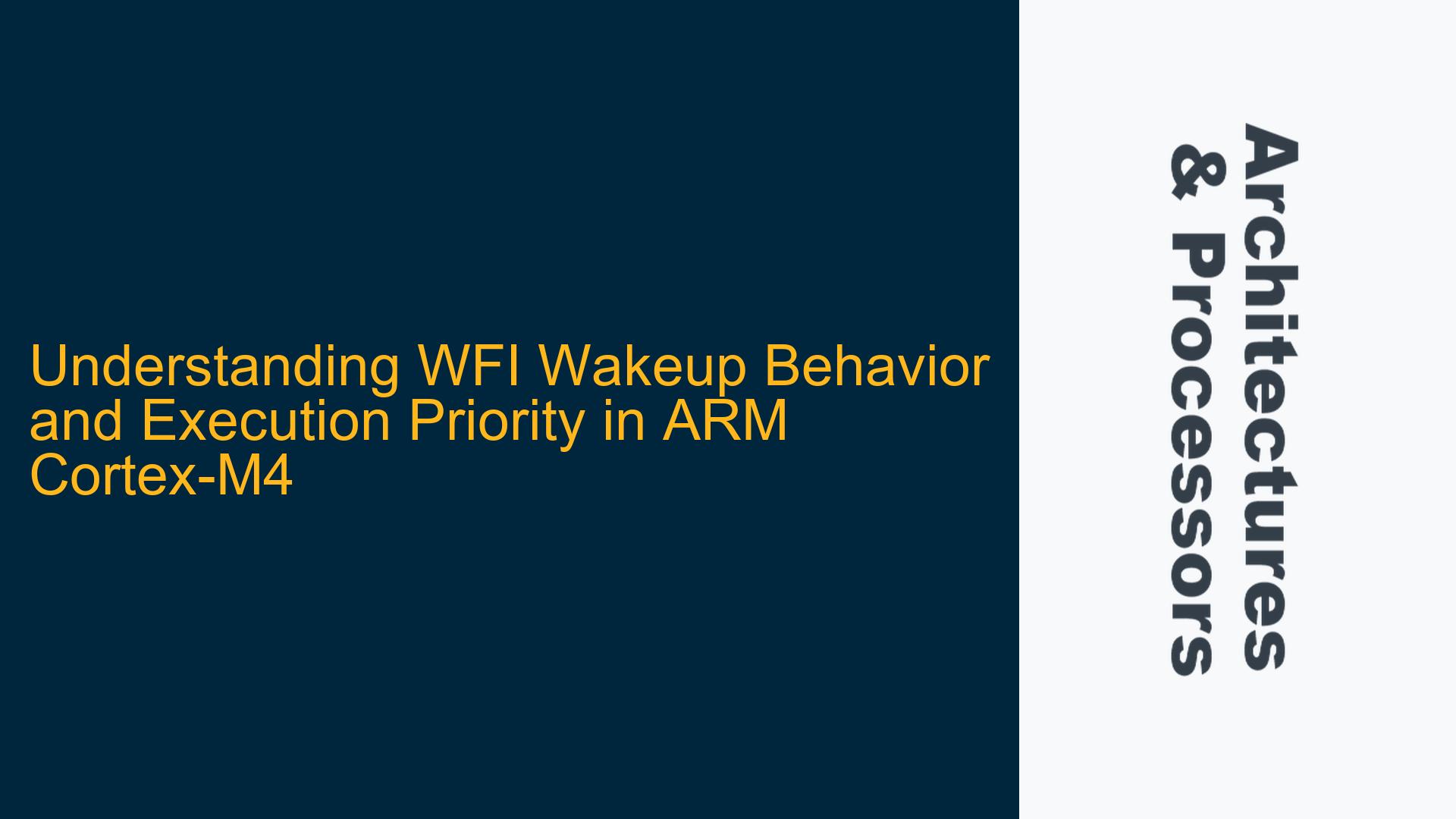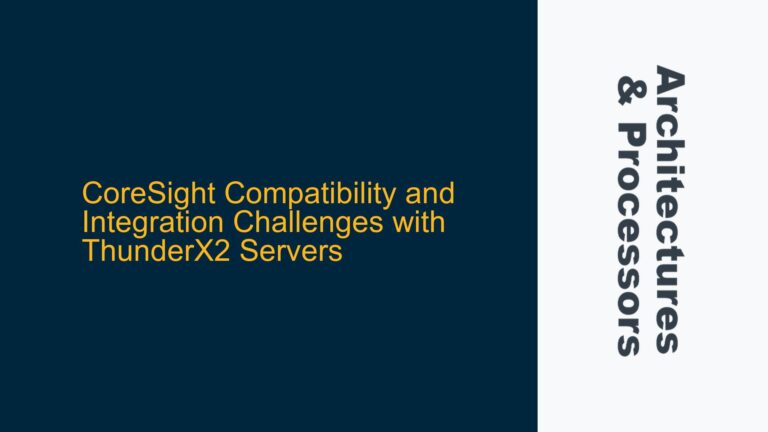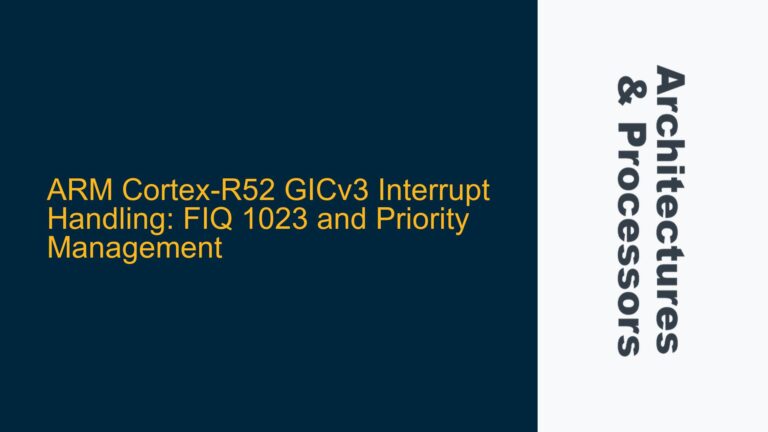ARM Cortex-M4 WFI Wakeup Behavior and Execution Priority Confusion
The ARM Cortex-M4 processor is widely used in embedded systems due to its balance of performance and power efficiency. One of its key features is the ability to enter low-power states using the Wait For Interrupt (WFI) instruction. However, the behavior of WFI, particularly in relation to interrupt priority and wakeup conditions, can be a source of confusion. This post delves into the intricacies of WFI wakeup behavior, the role of PRIMASK and BASEPRI registers, and the execution priority during WFI.
PRIMASK, BASEPRI, and Execution Priority During WFI
The PRIMASK and BASEPRI registers are critical in managing interrupt handling and execution priority on the ARM Cortex-M4. PRIMASK is a single-bit register that, when set to 1, disables all exceptions except for Non-Maskable Interrupts (NMI) and HardFault. BASEPRI, on the other hand, allows masking of interrupts with a configurable priority level. When BASEPRI is set to a non-zero value, all interrupts with a priority lower than the specified value are masked.
The execution priority is the effective priority at which the processor is currently running. This priority is determined by the highest priority of any active exception or the value of BASEPRI, whichever is higher. When PRIMASK is set to 1, the execution priority is effectively 0, which is the highest possible priority, because PRIMASK disables all exceptions except for NMI and HardFault.
The confusion arises when considering the interaction between WFI, PRIMASK, and BASEPRI. Specifically, the question is whether the processor can be woken from WFI by an interrupt that would not normally preempt the current execution priority due to PRIMASK being set.
WFI Wakeup Conditions and PRIMASK Ignorance
The ARM Cortex-M4 architecture specifies that the processor can be woken from WFI by several conditions, including a reset, a debug event, or an asynchronous exception. Importantly, the architecture documentation states that the processor ignores the value of PRIMASK when determining whether an asynchronous exception can wake the processor from WFI. This means that even if PRIMASK is set to 1, an interrupt with a priority higher than the current execution priority (which is 0 when PRIMASK is set) can still wake the processor from WFI.
This behavior is counterintuitive because one might expect that setting PRIMASK to 1 would prevent any interrupts from waking the processor. However, the architecture is designed this way to ensure that critical interrupts can always wake the processor, even if PRIMASK is set. This is particularly important in low-power applications where the processor needs to be able to respond to critical events while minimizing power consumption.
Troubleshooting WFI Wakeup and Execution Priority Issues
To troubleshoot issues related to WFI wakeup and execution priority, it is essential to understand the interaction between PRIMASK, BASEPRI, and the WFI instruction. Here are the steps to diagnose and resolve such issues:
-
Verify PRIMASK and BASEPRI Settings: Ensure that PRIMASK and BASEPRI are set correctly before entering WFI. If PRIMASK is set to 1, the execution priority is 0, and only NMI and HardFault can preempt the current execution. However, any interrupt with a priority higher than the current execution priority can wake the processor from WFI, regardless of PRIMASK.
-
Check Interrupt Priorities: Verify the priorities of the interrupts that are expected to wake the processor. If an interrupt with a priority lower than the current execution priority is waking the processor, this could indicate an issue with the interrupt configuration or a misunderstanding of the WFI wakeup behavior.
-
Review the SoC Manual: Different System on Chip (SoC) implementations may have additional wakeup conditions or behaviors that are not covered in the ARM architecture documentation. For example, some SoCs may allow any enabled interrupt to wake the processor, regardless of priority. Review the SoC manual to understand any implementation-specific behaviors.
-
Use Data Synchronization Barriers: When working with WFI and interrupt handling, it is crucial to ensure that all memory operations are complete before entering WFI. Use Data Synchronization Barrier (DSB) instructions to ensure that all memory accesses are complete before executing WFI.
-
Debugging with Breakpoints: If the processor is waking from WFI unexpectedly, use breakpoints to determine which interrupt is causing the wakeup. This can help identify whether the wakeup is due to a high-priority interrupt or an implementation-specific behavior.
-
Consider Debug Events: If debug is enabled, debug events can also wake the processor from WFI. Ensure that debug events are not causing unexpected wakeups by disabling debug or configuring debug events appropriately.
-
Implementing Cache Management: If the processor is waking from WFI due to cache-related events, ensure that the cache is properly managed. Use cache invalidation and cleaning instructions to ensure that the cache state is consistent before entering WFI.
-
Testing with Different Scenarios: Test the system with different interrupt priorities and PRIMASK/BASEPRI settings to understand the behavior under various conditions. This can help identify any edge cases or unexpected behaviors.
By following these steps, you can diagnose and resolve issues related to WFI wakeup and execution priority on the ARM Cortex-M4. Understanding the nuances of PRIMASK, BASEPRI, and WFI is crucial for developing reliable and efficient embedded systems.
Conclusion
The behavior of the WFI instruction in the ARM Cortex-M4, particularly in relation to interrupt priority and wakeup conditions, can be complex and counterintuitive. By understanding the roles of PRIMASK and BASEPRI, and the conditions under which WFI can be woken, developers can ensure that their systems behave as expected. Troubleshooting WFI wakeup issues requires a thorough understanding of the ARM architecture, careful configuration of interrupt priorities, and consideration of implementation-specific behaviors. With the right approach, developers can harness the power-saving capabilities of WFI while maintaining the responsiveness and reliability of their embedded systems.






